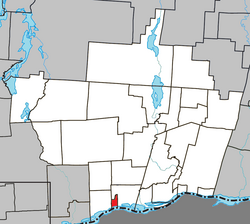
Gatineau is a city in south western Quebec, Canada. It is located on the northern bank of the Ottawa River, immediately across from Ottawa, Ontario. Gatineau is the largest city in the Outaouais administrative region and is part of Canada's National Capital Region. As of 2021, Gatineau is the fourth-largest city in Quebec with a population of 291,041, and a census metropolitan area population of 1,488,307 making it the fourth largest in Canada.

Maniwaki is a town in the province of Quebec, Canada. It is situated 130 kilometres (81 mi) north of Ottawa, Ontario, on the Gatineau River, at the crossroads of Route 105 and Route 107, near Route 117. The town is the administrative centre for La Vallée-de-la-Gatineau Regional County Municipality.
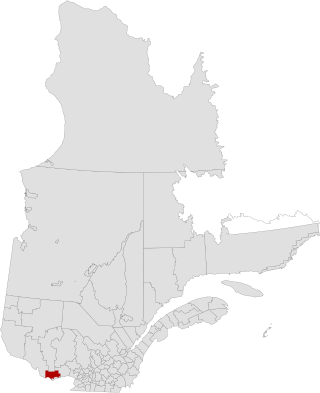
Les Collines-de-l'Outaouais is a regional county municipality in the Outaouais region of western Quebec, Canada. The region nearly encircles the City of Gatineau, which is to the south. Its administrative seat is in Chelsea, Quebec.
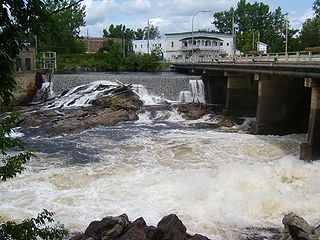
Mont-Laurier is a town and incorporated municipality in northwest Quebec, Canada, located on the banks of the Lièvre River, a tributary of the Ottawa River. Known as the "Capital of the Haute-Laurentides", the motto of the town is Laurus elationis praemium, which translates to "Lift the laurels of reward". The demonym for its inhabitants is Lauriermontois.
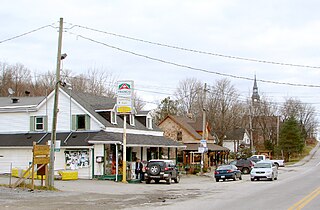
Chelsea is a municipality located immediately north of Gatineau, Quebec, Canada, and about 10 kilometres (6.2 mi) north of Ottawa. Chelsea is located within Canada's National Capital Region. It is the seat of Les Collines-de-l'Outaouais Regional County Municipality.

Fort Coulonge is a village in the Pontiac Regional County Municipality in western Quebec, Canada, at the mouth of the Coulonge River. It is the francophone centre of the otherwise largely (57%) anglophone Pontiac MRC, with 79.6% listing French as their mother tongue in the Canada 2006 Census.
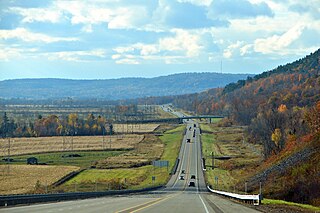
Autoroute 50 is an Autoroute in western Quebec, Canada. It links Canada's National Capital Region (Gatineau) and the Greater Montreal area (Mirabel).
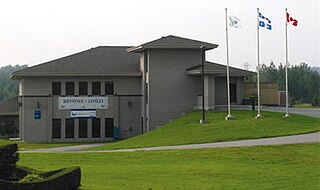
Cantley is a rural municipality in Quebec, Canada, north of the city of Gatineau, east of the Gatineau River, located within Canada's National Capital Region approximately 17 km (11 mi) from Parliament Hill. Cantley is one of six municipalities within the Collines-de-l'Outaouais Regional County Municipality. Its roots are in farmland and mining, but recent housing projects since its creation in 1989 have resulted in a high rate of population growth. The population at the 2021 Canadian Census was 11,449, an increase of 7.0% from the 2016 population of 10,699. French is the first language of 86.7% of Cantley's residents.
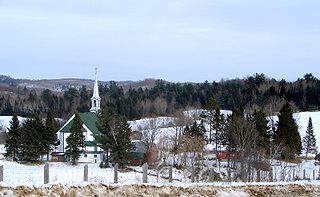
Mayo is a municipality in the Papineau Regional County Municipality of western Quebec, located northeast of the city of Gatineau. Mayo is south of the hamlet of Mulgrave-et-Derry.

Val-des-Monts is a municipality in the Outaouais region of Quebec, Canada, located about 40 km (25 mi) north of Ottawa, Ontario. It has a population of 13,328 residents in 2021. Formed in 1975 by the merger of the towns of Perkins, Saint-Pierre-de-Wakefield and Poltimore, it consists mainly of farms and mountainous forests. Many of its residents commute to Ottawa or Gatineau for work. Due to its numerous lakes, its population is boosted during summers by people living in cottages. Most of the people in Val-des-Monts live in the village of Perkins.

Plaisance is a municipality in Papineau Regional County Municipality in western Quebec, Canada. The village is situated on the Ottawa River near the mouth of the Petite-Nation River, 70 km from Gatineau and 160 km from Montreal on Route 148.

Gracefield is a city in La Vallée-de-la-Gatineau Regional County Municipality in the Outaouais region of Quebec, Canada. It was reorganized on 13 March 2002 when three former municipalities were merged into one.

L'Isle-aux-Allumettes is a municipality in the Outaouais region, part of the Pontiac Regional County Municipality, Quebec, Canada. The municipality consists primarily of Allumette Island, and also includes Morrison Island, Marcotte Island, and some minor islets, all in the Ottawa River north of Pembroke.
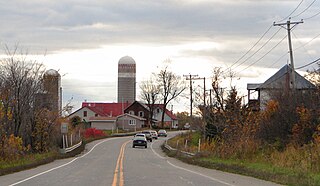
Lochaber is a township municipality in the Canadian province of Quebec, located within the Papineau Regional County Municipality. The township had a population of 415 in the 2016 Canadian Census.

Lochaber-Partie-Ouest is a township municipality in the Canadian province of Quebec, located within the Papineau Regional County Municipality. The township had a population of 926 in the 2021 Canadian Census.
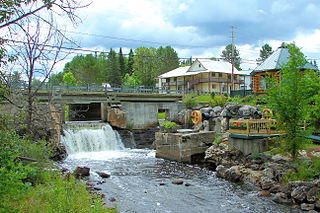
Aumond is a township municipality in the Canadian province of Quebec, located within La Vallée-de-la-Gatineau Regional County Municipality.

Alleyn-et-Cawood is a municipality in the Outaouais region, northwest of Gatineau, part of the Pontiac Regional County Municipality, Quebec, Canada. Its main population centre is Danford Lake, located along Route 301.
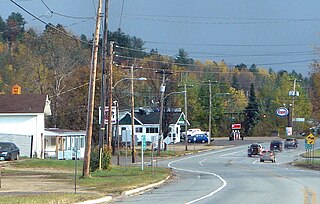
Grand-Remous is a town and municipality in La Vallée-de-la-Gatineau Regional County Municipality, Quebec, Canada. The municipality is south of the Baskatong Reservoir, spanning both sides of the Gatineau River. The town is situated at the intersection of Route 117 and Route 105.

Egan-Sud is a municipality in the La Vallée-de-la-Gatineau Regional County Municipality, Quebec, Canada, directly north of Maniwaki.
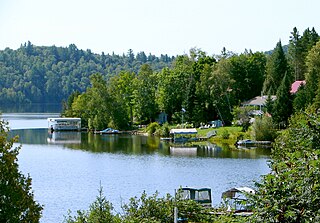
Bowman is a village and municipality in the Outaouais region of Quebec, Canada. It is located in the Laurentian Hills, 72 kilometres (45 mi) north-east of Gatineau.

